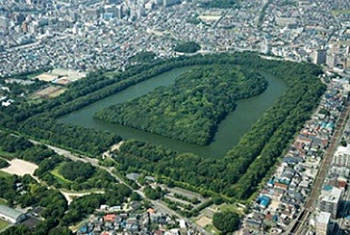Characteristics of Mozu-Furuichi Kofungun
A distinct type of burial mound, represented by keyhole-shaped kofun
 ▲ Nintoku-tenno-ryo Kofun
The densely concentrated mounded tombs are contemporaneous, yet varied; they come in four standardized plan types – keyhole shape, scallop shape, round and square – and in an extremely wide range in scale from 20 meters to nearly 500 meters in mound length.
Moreover, a kofun is a not a simple earth or piled-stone mound covering over a coffin or a burial chamber.
It is an exceptional architectural achievement that was designed as a stage for funerary rituals, decorated with paving stones and clay objects, and built with highly elaborate and geometry-based architectural planning and technology.
▲ Nintoku-tenno-ryo Kofun
The densely concentrated mounded tombs are contemporaneous, yet varied; they come in four standardized plan types – keyhole shape, scallop shape, round and square – and in an extremely wide range in scale from 20 meters to nearly 500 meters in mound length.
Moreover, a kofun is a not a simple earth or piled-stone mound covering over a coffin or a burial chamber.
It is an exceptional architectural achievement that was designed as a stage for funerary rituals, decorated with paving stones and clay objects, and built with highly elaborate and geometry-based architectural planning and technology.
A wide variety of burial mounds demonstrating the socio-political structure
The kofun illustrates that there once existed a highly sophisticated funerary system that suggested social class differences.
The most fully and clearly demonstrated hierarchical structure of the Mozu-Furuichi Kofun Group became the reference for kofun groups in other parts of the archipelago, situating it at the top of their hierarchy.
The way of social rule mediated by the kofun and the funeral rituals spread to a wide area of the archipelago.
 ▲ Hierarchical schema of kofun groups across the Japanese archipelago modeled on the structure of the Mozu-Furuichi Kofun Group
▲ Hierarchical schema of kofun groups across the Japanese archipelago modeled on the structure of the Mozu-Furuichi Kofun Group


